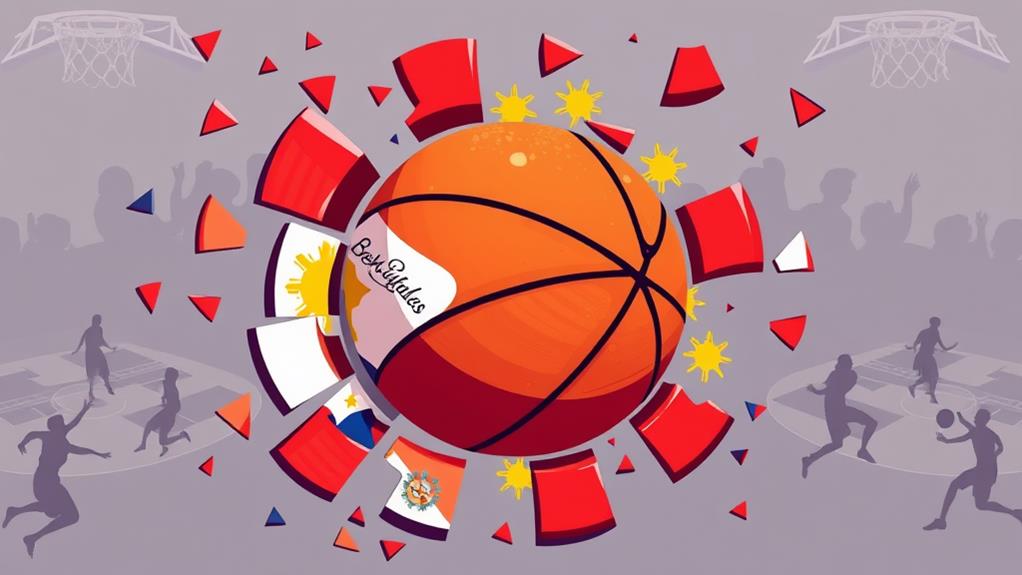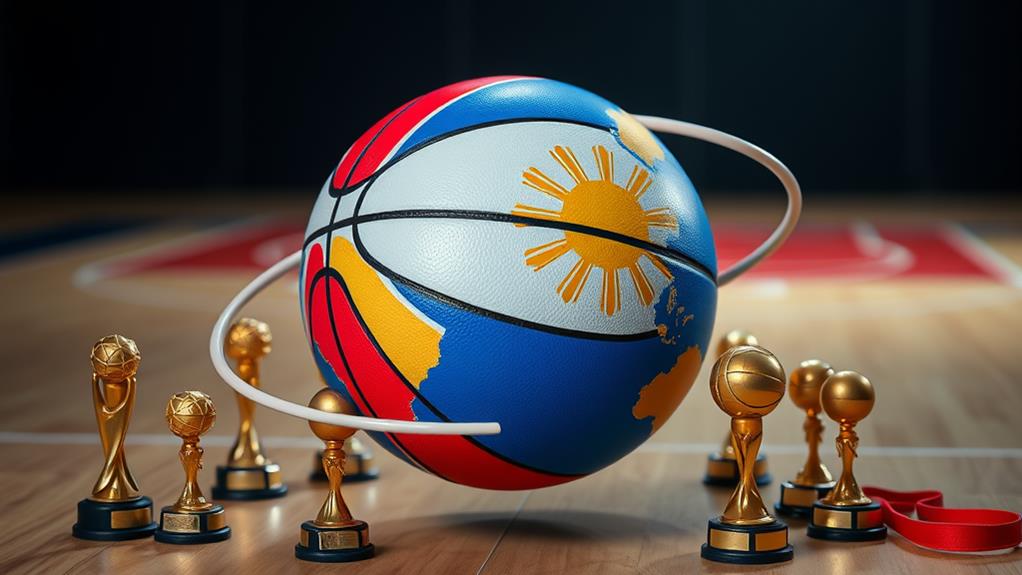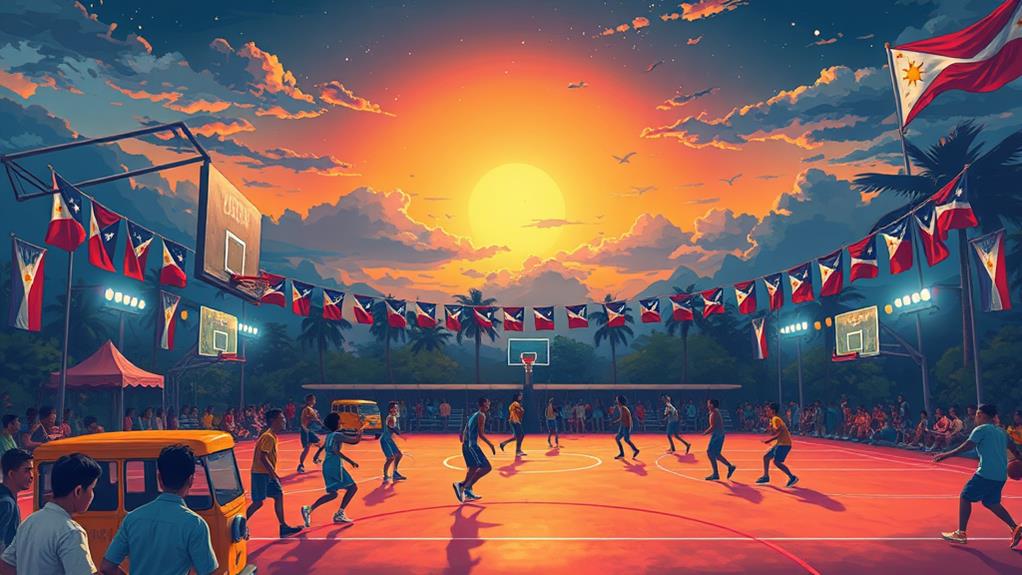Basketball has been the most popular sport in the Philippines for over a century. The country's national team achieved early international success, with roots dating back to the early 1900s. In recent years, the Philippines has also seen a growth in basketball tourism, with fans from around the world visiting to experience the passion and energy of the local basketball culture. To take advantage of this growing trend, the government has implemented sustainable tourism initiatives aimed at preserving the natural beauty and cultural heritage of the country while also promoting basketball as a major part of the travel experience. These initiatives include the development of eco-friendly sports facilities and the organization of basketball-themed tours that showcase both the sport and the country’s rich history and diverse landscapes.
The establishment of the Philippine Basketball Association (PBA) in 1975 solidified basketball's prominence in Philippine sports culture.
Today, basketball is a national pride symbol with professional leagues, grassroots programs, and infrastructure in place to nurture young talent.
The sport unites communities and inspires national pride, as seen in the widespread support for the national team and the popularity of local leagues.
The country's investment in basketball infrastructure has led to the development of top-notch facilities, further boosting its popularity.
The cultural significance of basketball in the Philippines is undeniable, with the sport playing a significant role in shaping the country's identity and sense of community.
From humble beginnings to international recognition, Philippine basketball has come a long way, and its impact on the nation's culture and society is undeniable.
Historical Roots of Basketball
Basketball was introduced to the Philippines in the early 1900s through YMCA programs and schools during the American colonial period. This introduction sparked a rapid growth in the sport's popularity, leading to the formation of the country's first men's national basketball team in the 1910s.
The team's success was evident in its gold medal win at the Far Eastern Championship Games in 1913, marking the Philippines' early achievement in international basketball.
The sport not only provided entertainment but also fostered community and social engagement, much like traditional Philippine folk dances promote cultural awareness and unity.
The establishment of the National Collegiate Athletic Association (NCAA) in 1924, with basketball as its primary sport, solidified the game's prominence in the country's sports culture.
By the 1950s, basketball became a symbol of national pride, with the Philippines winning its first gold medal in basketball at the 1951 Asian Games.
Moreover, basketball transcended socioeconomic barriers in the Philippines, becoming a national pastime with street courts prevalent in both urban and rural areas, fostering community engagement across diverse populations.
Professional Leagues and Competitions
Professional Leagues and Competitions in the Philippines
The Philippine Basketball Association (PBA), founded in 1975, is a pioneer in Asian professional basketball. It has played a vital role in the country's basketball development, shaping the sport's growth in the Philippines.
The PBA's influence is reflected in local cultural events, such as the Barangay fiestas, where communities come together to celebrate sports and traditional culture.
The men's national team, Gilas Pilipinas, has achieved significant international successes, making the country proud.
Gilas Pilipinas has won several titles, including the FIBA Asia Championship and the Southeast Asian Games. These achievements have contributed to the country's reputation as a basketball powerhouse in Asia.
PBA's Founding Years
The Philippine Basketball Association (PBA) was founded in April 1975 with eight pioneering teams, marking the birth of Asia's first professional basketball league. These teams included notable franchises like Crispa Redmanizers and Toyota Tamaraws, which became key competitors in the league's early years.
As the PBA gained popularity, it significantly contributed to the rise of basketball culture in the Philippines. Large crowds were drawn to games, and a passionate fan base was fostered.
The league introduced innovations such as a playoff system and a multi-conference format, enhancing its competitiveness.
Over the years, the PBA has produced numerous standout players and legendary teams, solidifying its status as a cornerstone of Philippine sports and contributing to the country's rich basketball heritage.
Today, the PBA remains a testament to the power of professional basketball in the Philippines.
Men's National Team
Gilas Pilipinas' International Achievements
The Philippine men's national basketball team, Gilas Pilipinas, has represented the country well in international competitions. They won a silver medal at the 2013 FIBA Asia Championship and qualified for the FIBA World Cup in 2014, 2019, and 2023.
Development of Local Talent
Gilas Pilipinas' success can be attributed to the development of local talent, thanks to the Philippine Basketball Association (PBA).
Established in 1975, the PBA is Asia's first professional basketball league, providing lucrative career opportunities for players to hone their skills and compete at the highest level.
Philippine Basketball History
The Philippines has a rich basketball history dating back to the early 1900s.
The country formed its first national team, which competed in the 1936 Olympic Games, finishing fifth.
Additionally, the Philippine national team won gold at the 1951 Asian Games and captured a bronze medal at the 1954 FIBA World Championship, the best finish for an Asian country in that competition.
Major Achievements
The Philippines has a rich basketball history, marked by significant achievements in professional leagues and competitions. The Philippine Basketball Association (PBA), established in 1975, is the first professional basketball league in Asia. This league has played a crucial role in developing basketball talent in the country.
On the international stage, the Philippines has made its mark with a gold medal at the 1951 Asian Games, its first major achievement in basketball. The Philippine national team also secured a bronze medal at the 1954 FIBA World Championship, the best finish for any Asian country in the tournament's history.
More recently, Gilas Pilipinas, the country's national team, has qualified for the FIBA World Cup in 2019 and 2023, showcasing the country's growing competitiveness.
Additionally, the Maharlika Pilipinas Basketball League (MPBL), launched in 2017, aims to promote local talent and develop grassroots basketball across the nation.
These achievements demonstrate the Philippines' passion and dedication to the sport.
Governance and Restructuring

The Philippines' basketball governance has undergone significant restructuring, transforming from a crisis-ridden past to a more robust system.
Recognition by FIBA marked a crucial turning point in 2007, as the Samahang Basketbol ng Pilipinas (SBP) gained recognition, ending the leadership crisis within the Basketball Association of the Philippines (BAP).
The establishment of the national team, Gilas Pilipinas, in 2007 has enabled the country to represent itself in international competitions, qualifying for the FIBA World Cup multiple times.
Local League Development has also been a key aspect of the restructuring, with the inauguration of the Maharlika Pilipinas Basketball League (MPBL) in 2017. This has enhanced local basketball governance and provided more competitive opportunities for players outside of professional leagues.
Furthermore, Grassroots Initiatives have emerged, including the National Basketball League (NBL), VisMin Super Cup, and Pilipinas Super League (PSL), which have diversified the landscape in Philippine basketball governance alongside the Philippine Basketball Association (PBA).
These developments have contributed to a more robust governance structure, paving the way for the growth of professional and grassroots basketball in the Philippines.
Infrastructure and Grassroots Development
The Philippines has an extensive network of basketball courts, with both public and private facilities providing ample opportunities for people to engage in the sport. This network allows for community participation, similar to traditional folk dances, where people come together to enjoy the activity.
Schools and universities have invested in state-of-the-art facilities, giving aspiring athletes the chance to develop their skills. For example, the University of Santo Tomas has a modern basketball court with professional-grade equipment, allowing its students to train and compete at a high level.
Grassroots programs are being implemented to nurture young talent, ensuring the country's passion for basketball continues to grow. For instance, the Philippine Basketball Association's (PBA) "PBA Jr." program provides training and development opportunities for young players, helping to identify and develop future talent.
Court Accessibility Nationwide
Court Accessibility Nationwide
The widespread availability of basketball courts has been instrumental in the sport's widespread adoption in the Philippines. This accessibility has contributed to the growth of the basketball community, providing opportunities for players to hone their skills and participate in the sport they love.
Thousands of Courts Nationwide
Thousands of basketball courts are scattered throughout the country, catering to both urban and rural areas. This widespread distribution ensures that players of all levels have easy access to facilities.
Government Support
Local government units frequently fund the construction and maintenance of basketball courts, ensuring that communities have facilities for regular play. This support enables communities to have access to quality facilities, promoting regular play and skill development.
School and University Facilities
Schools and universities have invested in sports facilities that meet international standards, promoting training and skill development for aspiring athletes.
For example, the University of Santo Tomas has a state-of-the-art sports complex that hosts regional and national basketball tournaments.
Grassroots Development Programs
Grassroots development programs actively work to improve basketball skills and provide opportunities for youth participation, further solidifying basketball's position as a national pastime.
The National Basketball Training Center, for instance, offers training programs and camps for young players, helping to develop their skills and passion for the sport.
Developing Youth Talent
The Philippines has a strong foundation for developing young basketball talent. With a basketball court in nearly every corner of the country, young athletes have ample opportunities to hone their skills.
Schools and universities are investing in top-notch sports facilities that meet international standards, providing quality training environments for aspiring young athletes.
Grassroots development programs are in place to enhance basketball skills among youth. These programs focus on accessibility and quality of training to nurture talent from a young age. This investment in youth development has led to the growth of leagues like the Women's National Basketball League (WNBL), which indicates a growing interest and support for female athletes.
Elite basketball clinics and training sessions, such as those led by USA Basketball coaches, aim to elevate the skill level of young Filipino players.
The country's investment in youth talent development is paying off, and it's an exciting time for young basketball enthusiasts in the Philippines. With these facilities and programs in place, young athletes can develop their skills and become one of the many talented Filipino basketball players.
Global Presence and Achievements

Global Recognition in Basketball
The Philippines has made significant strides in the global basketball scene, earning recognition and respect through its notable achievements.
The nation's growing competitiveness on the global stage is evident in its FIBA World Cup qualifications in 2019 and 2023. Filipino players are also making their mark in international leagues, with notable figures like Kai Sotto signing with the Orlando Magic for the 2023 Summer League.
The Philippines has achieved a historic bronze medal at the 1954 FIBA World Championship, marking the best finish for an Asian country in the tournament's history. This accomplishment showcases the nation's capability to compete at the highest level.
The country's strong fanbase is another significant factor in its global presence. In 2023, record engagements on localized NBA social media in the Philippines reached 923 million, highlighting the immense popularity of basketball in the country.
These achievements demonstrate the Philippines' commitment to developing its basketball team and increasing its global presence, solidifying its position as a popular sport in the country.
NBA Popularity in the Philippines
The NBA's immense popularity in the Philippines is undeniable. The country has a significant following, ranking second in Asia-Pacific for NBA League Pass subscribers.
Filipino fans have the third-largest average global audience for live NBA games, demonstrating their deep engagement with the sport.
The NBA's social media presence in the Philippines is remarkable. The NBA's Facebook page has over 6 million followers.
In 2023, the NBA recorded 923 million engagements on its localized social media accounts in the country, underscoring the passion of Filipino fans.
The NBA has become an integral part of the country's basketball culture. The opening of the second NBA Store in Metro Manila at SM Mall of Asia further signifies the growing retail and brand presence of the NBA in the Philippines.
Filipino Basketball Culture Unites

Filipino Basketball Culture Unites
Filipinos share a deep passion for basketball, which has become an integral part of the country's cultural fabric. Basketball is more than just a sport – it's a way of life.
Widespread Accessibility
Basketball courts are found in both urban and rural areas, making the sport accessible to people from all walks of life. This widespread accessibility allows individuals from different backgrounds to come together and share a common interest.
National Pride and Community Unity
The Philippine Basketball Association (PBA) has significantly contributed to the development of local talent and community pride. Major events like the FIBA World Cup and Asian Games unite communities and foster national pride.
Grassroots Engagement
Local leagues like the Maharlika Pilipinas Basketball League (MPBL) enhance community engagement and strengthen ties among players and fans of all ages. These leagues provide a platform for people to connect and share their love for basketball.
Global Presence
Filipino players participating in international leagues, such as the B. League and NBL, inspire local youth and highlight the global presence of Filipino basketball. This global presence has a profound impact on the country's identity.
Filipinos' love for basketball is evident in the way players play with passion and dedication. The sport has become an integral part of the country's identity, and its impact is felt far beyond the court.
How has the popularity of basketball in the Philippines influenced the role of sports in Filipino entertainment and popular culture?
Basketball’s popularity in the Philippines has greatly impacted the role of sports in filipino entertainment. The sport has become a major part of popular culture, with basketball games often drawing large crowds and becoming a focal point of community events. It has become a significant aspect of Filipino entertainment.
Why are sports like volleyball and football gaining popularity in the Philippines alongside basketball?
In the Philippines, basketball has long been the top sport, but volleyball and football are also becoming popular sports in philippines. These sports are gaining popularity due to the increase in exposure through international competitions and the rise of local leagues and tournaments dedicated to volleyball and football.
Local Impact and Community Engagement
Basketball's Unifying Force in Filipino Communities
Basketball has a profound impact on local life in the Philippines, serving as a unifying force that brings people together across urban and rural areas. With thousands of public and private courts, the infrastructure is in place to foster daily engagement.
Local leagues and tournaments, such as the Maharlika Pilipinas Basketball League (MPBL), strengthen community ties and encourage teamwork among players of various backgrounds.
Community Bonding and Cultural Pride
The popularity of basketball is akin to traditional folk dances, which also promote community bonding and cultural pride.
The Philippine Basketball Association (PBA), established in 1975, plays a crucial role in developing talent and providing lucrative career opportunities, further embedding basketball into the local culture.
Celebrating Cultural Pride and Community Visibility
Notable events and competitions, like the USFBA tournament, celebrate cultural pride and enhance community visibility, bringing together players from diverse age groups and backgrounds.
Through basketball programs and clinics, young athletes can grow personally and collectively within their communities, inspired by mentorship opportunities.
Conclusion
Basketball's widespread popularity in the Philippines stems from its rich history, professional leagues, and grassroots development. The sport's governance has undergone significant restructuring, leading to improved infrastructure and increased global presence.
The NBA's massive following in the country has contributed to its widespread appeal. In fact, the NBA has been broadcasted in the Philippines since the 1980s, making it a household name.
Basketball has become an integral part of Filipino culture, uniting people across the nation. For instance, many Filipino families bond over watching NBA games together or playing basketball in local courts.
With its local impact and community engagement, it's clear that basketball will remain the Philippines' most beloved sport for years to come. The sport's influence can be seen in the numerous local leagues, tournaments, and basketball courts that have sprouted across the country.